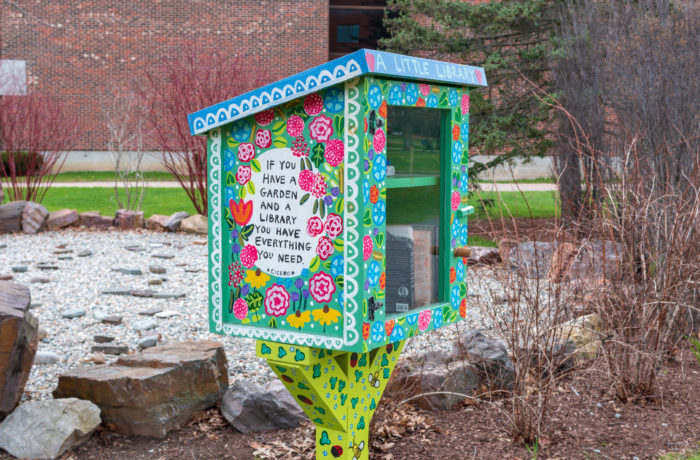
By Sixiang Chen
International Editor
This time of year makes Fengting Zheng ‘19, particularly homesick.
“I miss Lunar New Year, and I miss my parents,” Zheng said recently as she sat at a table in Alliot. The Lunar New Year, which takes place Feb. 16, is traditionally a time of family reunions in China.
Zheng who was born and raised in Shenzhen, Southern China, arrived in Vermont three years ago to attend St. Michael’s College and has not had a reunion with her family on Lunar New Year since her arrival here.
Different from Jan. 1, Lunar New Year is celebrated at the turn of the traditional lunisolar Chinese calendar. Traditionally, it is a time to honor deities as well as ancestors.
“Lunar New Year is based upon the monthly cycles of the Moon’s phases,” said Zheng. “For example, last year it was Jan. 26, and this year it is celebrated on Feb. 16.“It is celebrated for 15 days, the last day is Lantern Festival, which means hoping everyone has a happy life in the new year.”
When Lunar New Year comes in China, the first thing every family does is to set off firecrackers in front of the door at 12 a.m., which cleans away the past year and ushers in the new.
“We stick the ‘reversed Fu’ and some couplets on the front door,” said Chuck Qian ’20, born and raised in Shanghai, Southern China. He explained that in Chinese, the “Fu” means happiness, and reversed Fu, pronounced as “Fu Dao Le,” means happiness is coming. The couplets might be about peace, luck, fortune, and other good wishes.
“We usually stay up late or all night on Lunar New Year’s Eve. That night, the whole family will have a reunion, eat special dinner, light candles, sit next to the heating stove, and wait for the moment of ringing the bell, a symbol of driving all evils away and looking forward to the New Year’s auspicious sign,” Qian said.
The next day in China, people will “Bai Nian,” paying a visit, to their elders, to bring good health. The elders will give red envelopes with money to the younger relatives. The color red symbolizes happiness.
After the visit, people will sit and chat and often the conversation leads to the 12 Chinese zodiacs. “In the West, there are 12 constellations. In Asia, we have 12 Chinese zodiacs,” said Haobo Wang ’19, who was born and raised in Beijing, Northern China.
In Chinese astrology, the 12 signs are derived from a myth that when the Jade Emperor (the Supreme Deity of Taoism) was developing a calendar, all creatures on Earth were summoned to participate in a race. The first 12 to cross the line were awarded signs in the Chinese zodiac — Rat, Ox, Tiger, Rabbit, Dragon, Snake, Horse, Goat, Monkey, Rooster, Dog, and Pig.
Each year is a different year of an animal, and 12 years constitutes a period. The year of 2018, for example, is a year of the dog, the same as 2006 and 1994. The sign of dog is linked to loyalty and honesty.
“Since I am a Pig in the Chinese horoscope, the year of 2019 will be my year of fate,” Wang said. In China, the year of pig is especially desirable because pigs are lazy and fat, meaning you don’t work but you have a lot of money. “In their year of fate, older generations will wear red underwear to bless themselves in obtaining peace and good fortune throughout the year, but this custom fades away in the young generations,” Wang said.
Zheng, Qian and Wang have now lived in the United States about three years. Because their families do not live in the United States, the Lunar New Year is more challenging to celebrate. However, they will have a small celebration with friends on St. Michael’s College campus and have a meal together. They will also talk with their families through the Internet and send a festive message to them.
“Actually, the old generations pay more attention to the customs of Lunar New Year. The younger generations, however, are more casual,” Zheng added. “My parents would go to the elders’ houses, but younger generations prefer to send greeting cards as a mark of their respect.”
St. Michael’s College lays emphasis on the traditional festivals of international students as well as Lunar New Year.
“At the moment there are over 30 Chinese students on our campus. So it is expected that the desire to have Chinese celebrations would be high,” said Kimoi A. Seale ’06, an assistant dean in student affairs as well as an assistant Director in the Center for Multicultural Affairs and Services (CMAS).
“[Chinese New Year] has become a tradition for the GEAR residents along with the Center for Multicultural Affairs and Services to plan a celebration for the Chinese New year,” Seale said.
“We recognize it’s not the same as their experience at home, but we hope to get as close to it as we can,” Seale said.
For more information, contact Kimoi Seale at the CMAS office, or email him at kseale@smcvt.edu.


